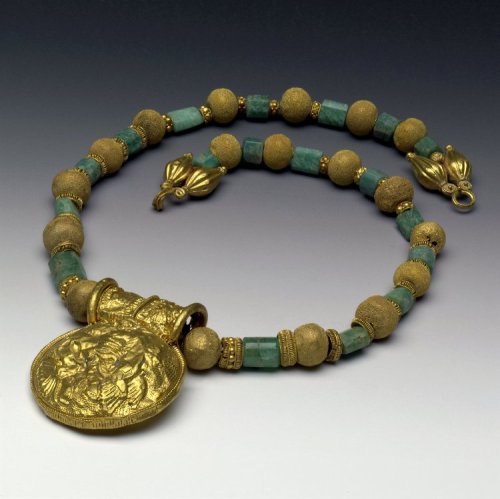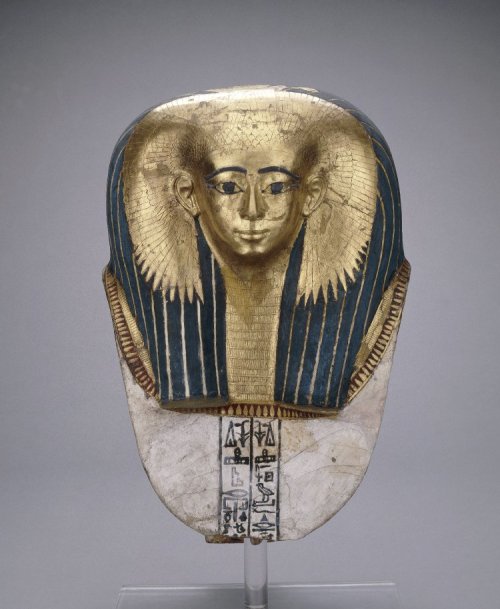Mudstone statue of a woman, Ancient Egypt, 30th Dynasty The...

Mudstone statue of a woman, Ancient Egypt, 30th Dynasty
The British Museum
Gold lunula, 2400 BC-2000 BC, Found in Ireland, Late...

Gold lunula, 2400 BC-2000 BC, Found in Ireland, Late Neolithic/Early Bronze Age
The British Museum
Bell Krater, Attributed to The McDaniel Painter, Ancient Greece,...

Bell Krater, Attributed to The McDaniel Painter, Ancient Greece, 380 BC-370 BC
The British Museum
The Chatsworth Head, Ancient Greece, 470 BC-460 BC "The statue...

The Chatsworth Head, Ancient Greece, 470 BC-460 BC
"The statue was found complete by peasants in 1836 in the bed of the Pediaeos river north of the village of Politiko (ancient Tamassos) in central Cyprus. The findspot was later revealed by excavation to have been a very important sanctuary dedicated to Apollo. According to the account of the finders preserved in Ludwig Ross's account of his visit to Cyprus in 1845, the statue was naked, with the exception of a wide belt, with the left foot extending forward. The arms, legs and head were cast separately from the body, indicated by the fact thay they broke off as the statue was dragged away from the site.The existence of the belt suggests a more archaic form for the body than the head, whose closest parallels lie in the Severe Style of Greek sculpture in the second quarter of the 5th century BC.
The staue was broken up and sold for scrap bronze for a very low price, with the exception of the head which came into the possession of an English collector and dealer who later sold it on to the Duke of Devonshire. Cornelius Vermeule suggests the statue was a cult image similar to that from the temple of Apollo at Miletos and furnishes the origin with arrows or a phiale in one hand and a bow in the other, though this is not certain as cult statues of this kind are very rare on Cyprus"
The British Museum
Bronze statuette of a huntsman, probably representing Alexander...

Bronze statuette of a huntsman, probably representing Alexander the Great, Hellenistic, 250 BC-100 BC
The British Museum
Marble head from a statue of the young Herakles or an athlete,...

Marble head from a statue of the young Herakles or an athlete, 2nd c BCE, Ancient Rome
The British Museum
Marble statue of a draped woman, Ancient Turkey, 2nd c BCE The...

Marble statue of a draped woman, Ancient Turkey, 2nd c BCE
The British Museum
Marble head of a young woman wearing a taenia (headband),...

Marble head of a young woman wearing a taenia (headband), Ancient Rome, c 200 CE
The British Museum
Necklace, Etruscan, 5th C BC - 2nd C BC The British Museum

Necklace, Etruscan, 5th C BC - 2nd C BC
The British Museum
The Nereid Monument, Ancient Greece, 400 BCE The British Museum

The Nereid Monument, Ancient Greece, 400 BCE
The British Museum
Bronze parade mask: a woman's face, perhaps worn by...

Bronze parade mask: a woman's face, perhaps worn by soldiers representing Amazons, 2nd century, Ancient Rome
The British Museum
The Sophilos Dinos, Painted by Sophilos, Ancient Greece, 580...

The Sophilos Dinos, Painted by Sophilos, Ancient Greece, 580 BC-570 BC
"It shows the Wedding of Peleus and Thetis, above friezes of real and imaginary animals. Peleus receives the wedding guests at his house; among them Dionysos, Hebe, and the centaur Cheiron. Between the columns of Peleus' house is the artist's signature "Sophilos painted me". The first chariot in the procession carries Zeus and Hera, the second Poseidon and Amphitrite, the third Hermes and Apollo and the fourth Ares and Aphrodite. Between the chariots walk groups of Fates, Graces and Muses, one of whom plays the pipes. Athena and Artemis ride in the last chariot, and are followed by Thetis' grandfather, the fish-tailed sea-god Okeanos, his wife Tethys, and Eileithyia, goddess of childbirth. Hephaistos brings up the rear, seated side-saddle on a mule."
The British Museum
Bracelets, Lapis Lazuli and gold, 940 BCE, 22nd Dynasty Ancient...


Bracelets, Lapis Lazuli and gold, 940 BCE, 22nd Dynasty Ancient Egypt
"Gold cuff bracelet of Prince Nemareth: the inner side of the smaller segment of this bracelet is inscribed for a man with the Libyan name of Nimlot (also rendered as Nemareth or the like). The external decoration of the bracelet consists of geometric decoration and a figure of a child god. The god is represented in a typical ancient Egyptian manner for a male child: nude, wearing a long sidelock of hair and with a finger to the mouth. That this is not a mere human child, however, is indicated by his crook-shaped scepter of rule, the uraeus on his forehead, and his headdress, which is a lunar crescent and disk. The deity depicted on these bracelets is most probably Harpocrates. Two uraei guard the lunar symbols. Presumably, they represent the protective goddesses of Upper and Lower Egypt, which the Egyptians often equated with the ordered universe. And the blue lotus, on several of which the deity squats, is a symbol of creation from the primordial ocean, from which the sun first rose, and of birth and rebirth, presumably because that flower rises above the water when it opens each dawn. The bracelet was once inlaid with lapis lazuli."
The British Museum
Mummy mask, Early 18th Dynasty Ancient Egypt, 1500...

Mummy mask, Early 18th Dynasty Ancient Egypt, 1500 BCE
"Cartonnage mummy-mask of Satdjehuty: on this splendid female mask, gold leaf not only covers the woman's face, but also her huge collar necklace and the vulture-headdress that embrace the front and sides of her voluminous, lapis lazuli-coloured wig. The wings are examples of protective symbolism that, like the feather patterns on many anthropoid coffins of the Seventeenth and early Eighteenth Dynasties, evokes the guardianship of Isis and other deities. This woman's name, once written at the bottom of each column of hieroglyphs, has been lost. There are two columns of hieroglyphic text on the chest."
The British Museum
Statue of Ruler Senusret III, 12th Dynasty Ancient Egypt, 1874...

Statue of Ruler Senusret III, 12th Dynasty Ancient Egypt, 1874 BC-1855 BC
The British Museum
Mummy Case, Egypt, Roman Period, Early 2nd century "Mummy of a...

Mummy Case, Egypt, Roman Period, Early 2nd century
"Mummy of a Greek youth, aged 19-21, named Artemidorus in a cartonnage body-case with mythological decoration in gold leaf and an encaustic on limewood portrait-panel covering the face and inscription on the chest. There is an inscription in Greek on the mummy-case."
The British Museum
Relief with a seated man (The Lansdowne Homer) Greek, about...

Relief with a seated man (The Lansdowne Homer)
Greek, about 75 B.C.
Marble
The J. Paul Getty Museum
Wine cup with scenes of Bacchus and his consort Ariadne Roman,...

Wine cup with scenes of Bacchus and his consort Ariadne
Roman, Rome, 25 B.C. - A.D. 25
Cameo glass
The J. Paul Getty Museum
Ceremonial Chair (The Elgin Throne) Greek, 400 - 300 B.C. ...

Ceremonial Chair (The Elgin Throne)
Greek, 400 - 300 B.C.
Marble
The J. Paul Getty Museum
"A rare surviving example of Greek marble furniture, the Elgin Throneoriginally was placed in a public space in Athens, perhaps in the Theater of Dionysos, where it would have been a seat of honor. The decoration on the sides of the chair appears connected with this official function."
Storage jar with the judgment of Paris Greek, Athens, about...

Storage jar with the judgment of Paris
Greek, Athens, about 360 B.C.
Terracotta, pigment, and gold
The J. Paul Getty Museum
Комментариев нет:
Отправить комментарий